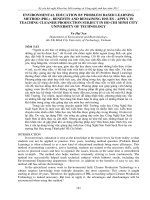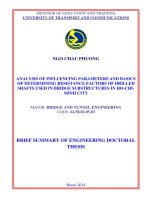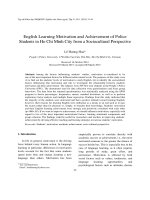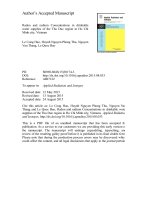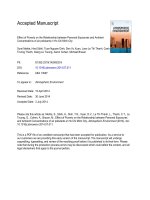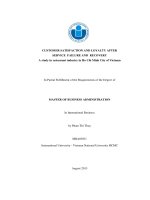Emotional intelligence, adaptive selling, improvisation and sales performance a study on salespeople in ho chi minh city
Bạn đang xem bản rút gọn của tài liệu. Xem và tải ngay bản đầy đủ của tài liệu tại đây (1.77 MB, 82 trang )
UNIVERSITY OF ECONOMICS HO CHI MINH CITY
International School of Business
------------------------------
Nguyen Thi Han
EMOTIONAL INTELLIGENCE, ADAPTIVE
SELLING, IMPROVISATION AND SALES
PERFORMANCE. A STUDY ON
SALESPEOPLE IN HO CHI MINH CITY.
MASTER OF BUSINESS (Honours)
Ho Chi Minh City-Year 2016
UNIVERSITY OF ECONOMICS HO CHI MINH CITY
International School of Business
------------------------------
Nguyen Thi Han
EMOTIONAL INTELLIGENCE, ADAPTIVE
SELLING, IMPROVISATION AND SALES
PERFORMANCE. A STUDY ON
SALESPEOPLE IN HO CHI MINH CITY.
ID: 22130019
MASTER OF BUSINESS (Honours)
SUPERVISOR: Dr. LE NHAT HANH
Ho Chi Minh City-Year 2016
ACKNOWLEDGEMENT
Firstly, I would like to express my gratefulness to my supervisor Dr. Le Nhat Hanh for
her professional guidance, intensive support, valuable suggestions, instructions and
encouragement during the time of doing my research.
I would like to express my deepest gratitude to Dr. Nguyen Dong Phong, Dr. Tran Ha
Minh Quan, Dr. Nguyen Dinh Tho, Dr. Nguyen TN Que and Dr. Pham Phu Quoc for their
valuable time as the members of the thesis examination committee. Their comments and
meaningful suggestions were contributed significantly for my completion of this research.
My sincere thanks are given to all of my teachers at International Business School –
University of Economics of Ho Chi Minh City for their teaching and guidance during
my master course.
ABSTRACT
Today, the market is extremely competitive, many international retail groups have
entered the market, providing greater choices for consumers whilst creating intense competitive
challenges. A key challenge facing firms is to determine how to deploy highly effective
salesforce in order to perform in this complex environment. In this dissertation, the study
examines the mutual impact of emotional intelligence on adaptive selling and improvisation,
and subsequently exploring its effect on sales performance in Vietnam. A combination of mail
and in person survey was used to collect the data. A pilot test was conducted prior to final
survey administration.
The results of the data illustrated strong support for the conceptual model. This study contribute
to sales management literature by understanding emotional intelligence-sales performance
relationship. Consequently, these findings indicate several managerial implications for
recruitment, training, work practices, and policies at the workplace.
Key words: emotional intelligence, adaptive selling, improvisation and sales performance
CONTENTS
ACKNOWLEDGEMENT
ABSTRACT
ABBREVIATION
Chapter 1: INTRODUCTION.................................................................................................... 1
1.1 Background to the research and research problem ........................................................ 1
1.2 Research objectives ........................................................................................................ 5
1.3 Research methodology ................................................................................................... 5
1.4 Research structure .......................................................................................................... 5
Chapter 2: LITERATURE REVIEW......................................................................................... 7
2.1 Adaptive selling and Improvisation ............................................................................... 7
2.2 Emotional Intelligence ................................................................................................... 8
2.3 Sales Performance ........................................................................................................ 10
2.4 Adaptive selling, Improvisation and Sales Performance ............................................. 12
2.5 Emotional Intelligence and Sales performance ........................................................... 14
2.6 Conceptual model ........................................................................................................ 15
Chapter 3: METHODOLOGY ................................................................................................. 17
3.1 Research design ........................................................................................................... 17
3.1.1 Research process ..................................................................................................... 17
3.1.2 Measurement scales ................................................................................................. 19
3.2 Quantitative study ........................................................................................................ 22
3.2.1 Sample ..................................................................................................................... 22
3.2.2 Data analysis procedures ......................................................................................... 23
Chapter 4: DATA ANALYSIS ................................................................................................ 25
4.1 Respondents’ demographics ........................................................................................ 25
4.2.1 CFA for the first-order constructs ........................................................................... 27
4.2.2 CFA for second-order constructs ............................................................................ 33
4.2.3 CFA for the final measurement model .................................................................... 36
4.3 Structural equation modeling (SEM) ........................................................................... 41
4.4 Discussion .................................................................................................................... 44
Chapter 5: CONCLUSION, IMPLICATIONS, AND LIMITATION..................................... 48
5.1 Managerial implications............................................................................................... 48
5.2 Limitations and future research ................................................................................... 49
REFERENCES ........................................................................................................................ 51
APPENDICES ......................................................................................................................... 56
LIST OF FIGURES
Figure 2.1 Conceptual model .................................................................................................. 15
Figure 3.1 Research process ................................................................................................... 18
Figure 4.1 CFA model of Improvisation ................................................................................. 28
Figure 4.2 CFA model of Adaptive selling .............................................................................. 30
Figure 4.3 CFA model of Sales Performance ......................................................................... 31
Figure 4.4 CFA model of Emotional Intelligence .................................................................. 34
Figure 4.5 Final measurement model ...................................................................................... 40
Figure 4.6 Structural results (standardized estimates) ............................................................ 42
LIST OF TABLES
Table 3.1 Source of data collection ......................................................................................... 22
Table 4.1 Respondents’ characteristics ................................................................................... 27
Table 4.2 The first run of CFA (of Improvisation, Adaptive selling and Sales performance) 29
Table 4.3 Summarized of CR, AVE and Cronbach’α (first order constructs) ........................ 32
Table 4.4 The first run of CFA (Emotional Intelligence) ....................................................... 33
Table 4.5 Summarized of CR, AVE and Cronbach’α (Emotional Intelligence) .................... 35
Table 4.6 Correlation (Emotional Intelligence) ....................................................................... 36
Table 4.7 Summarized of CR, AVE and Cronbach’α (final model)....................................... 36
Table 4.8 CFA Summary of eliminated item .......................................................................... 38
Table 4.9 Correlations (final measurement model) ................................................................ 39
Table 4.10 Unstandardized structural paths ............................................................................ 41
Table 4.11 Measurement validation ........................................................................................ 43
LIST OF APPENDICES
Appendix A List of in-depth interviews’ participants ............................................................ 61
Appendix B Qualitative in-depth interview ............................................................................ 61
Appendix C Qualitative in-depth interview findings .............................................................. 64
Appendix D Questionnaire (English Version) ........................................................................ 67
Appendix E Questionnaire (Vietnamese Version) .................................................................. 70
Appendix F Correlations among components of Emotional Intelligence, Adaptive selling,
Improvisation and Sales Performance ..................................................................................... 73
ABBREVIATION
AVE
Averaged variance extracted
CFA
Confirmatory Factor Analysis
EI
Emotional Intelligence
HR
Human Resource
MSCEIT
Mayer Salovey Caruso Emotional Intelligence Test
SEM
Structural equation modeling
SPSS
Statistical Package for the Social Sciences
TNS
Taylor Nelson Sofres
TPP
Trans-Pacific Partnership Agreement
WTO
World Trade Organization
Chapter 1: INTRODUCTION
1.1 Background to the research and research problem
Over the last 30 years since Doi Moi, the policy of opening the country and integrating into
the international economy has become a primary strategy of Viet Nam, in line with structural
reforms, aiming at economic growth and sustainable development. The reforms have changed the
lives of Vietnamese consumers. At present, the country represents an attractive market with vast
potential. According to Kearney (2008), with a population of nearly 90 million people, rapid
economic development, relative political stability, and an underdeveloped local retail system, it
was the most attractive emerging market destination for retail investment. Major international
retailers wish to penetrate deep into this market. In accordance with its World Trade Organization
(WTO) commitments— Vietnam became a member of the WTO in 2007—Vietnam fully opened
its retail sector after January 2009. Furthermore, Vietnam also stand out among the TPP countries
and Vietnam’s average applied tariffs on imports are 9.5%, one of the highest levels among TPP
members. Many international retail groups have entered the market, providing greater choices for
consumers whilst creating intense competitive challenges for domestic players. Domestic retailers
and the Vietnamese authorities have raised concerns about losing market share to new foreign
retail giants.
A relatively young population, coupled with rising income levels, increased urbanisation,
and an attractive business environment supported by lower trade barriers and reduced corporate
tax rates, have enhanced Vietnam’s position as a high potential growth market. A survey by the
Taylor Nelson Sofres (TNS) World Panel Vietnam revealed three major characteristics among the
new generation of consumers. First, they are younger than those in the previous generations (50
1
percent of Vietnamese consumers are less than thirty years old) and have high and complicated
product requirements. Second, they spend more on body and health care products and appreciate
product utility. Third, they tend to enjoy shopping in safe and comfortable environments (VNN
2008). So, with the increasing incomes and living standards, they have become more concerned
about the quality, hygiene and safety of the products purchased. Hence, there has been a slight
shift towards modern trade outlets for the hygienic, convenient and friendly shopping
environments that they offer. Enterprises have also implemented a wide variety of programmes to
build customer loyalty and attract new customers. These active young consumers represent a
powerful new consumer force driving trends that affect most of the country’s industries, especially
the modern retail sector.
Fundamental issues of the customer and their expectations involve around three magical
questions 1.What more? 2.What next? 3.What else? Salespeople are facing the challenge of
structuring the new product development processes. At the same time, organizations are
constrained by limited financial and human resources, a lack of a market orientation. As a result,
the role of organizations and individuals in providing goods and service is continuously
developing, the sale function is required to adapt and change. Therefore, a salesforce must have a
wide range of skills to compete successfully. This is because nothing can replace the power of
personal sales-force in generating sales and building strong, loyal customer relationship (Kurtz &
Boone, 2008; Kotler & Armstrong, 2005; Paparoidomis & Guenzi, 2009). Boone and Kurtz claim
that “professional salespersons are problem-solvers who focus on satisfying the needs of customers
before, during and after the sales are made” (2008, p. 529). Salespeople arm themselves with
knowledge about their firm’s goods and services, those of competitors and their customer’s
business needs, and pursue a common goal of creating long-term relationships with customers.
2
Salespeople play a key role not only in customer relationship management but also in
understanding, creating, communicating and delivering values to customers, which in turn
increases the sales performance of the firm (Paparoidomis & Guenzi, 2009; Weitz & Bradford,
1999). Firms need to have very high performing, productive and motivated salespersons in order
to succeed. Therefore, it is not surprising that practitioners and researchers have long sought to
gain deep insight into the characteristics of an effective salespersons.
In the past two decades, researchers within the field of selling have prescribed many
different relational-selling behaviors to salespeople, presumably leading to better sales
performance, such as customer-oriented selling (Schwepker, 2003), adaptive selling (Park &
Holloway, 2003), key account selling (Guenzi, Pardo & Georges, 2007; Jones et al., 2005), and
relationship selling (Crosby, Evans & Cowles, 1990). In a similar vein, the focus in the evolved
sales process, leading to high performance, is on customer relationship maintenance, satisfying
needs, and nurturing relationships (Moncreif & Marshall, 2005). All these different prescriptions
or requirements of the salespeople demand advanced interpersonal skills such as the ability to
handle conflicts (Weitz & Bradford, 1999) and be empathic (Rozell, Pettijohn & Parker, 2004) or
persuasive (Cron et al. 2005). On the other hand, several studies have examined specific emotions
in marketing encounters such as fear and anxiety (Verbeke & Bagozzi, 2000), cheerfulness and
excitement (Chitturi, Raghunathan & Mahajan, 2008), gratitude (Palmatier et al., 2009), anger and
frustration (Wagner, Hennig-Thurau & Rudolph, 2009), and shame and guilt (Agrawal &
Duhachek, 2010), research has not addressed salespeople’s abilities to recognize and respond to
their own and their customers’ emotions and have not considered how these abilities affect
building relationships between salespersons and clients and sales performance.
3
Emotional intelligence is the ability to acquire and apply knowledge from one’s emotions
and those of others to produce beneficial outcomes (Mayer & Salovey, 1997). Previous studies in
this area have generally examined the salespersons from mostly Western countries such as the
United States of America (Anderson & Nichols, 2007; Barrick, Parks & Mount, 2005), the United
Kingdom (Souchon et al., 2003), New Zealand (Gray, Matear, Basoff & Matheson, 1998) and
other European countries such as Germany and the Netherlands (Birgelen, Ruyter & Wetzels,
2000, 2001). Many researchers agree that in order to generalise the model of the impact of human
behaviour on successful performance, it is essential to examine the effects under various
environmental situations and circumstances (Lopez, Carr, Grgory & Dwyer, 2005; Wong & Law,
2002). In Vietnam, emotional intelligence has been studied in employee engagement (Khuong &
Yen, 2014). The marketing literature has largely ignored this ability-based conceptualization of
emotional intelligence despite its potential to benefit people who have high emotional intelligence
and also those with whom they interact, such as customers, in exchange relationships. For example,
recent research has suggested that sellers’ greater emotion recognition during negotiations with
buyers can increase payoffs for both sellers and buyers (Elfenbein et al., 2007). By increasing joint
value, sales professionals create greater outcome satisfaction for buyers and increase the likelihood
of future business (Martin et al., 2008; Mueller & Curhan, 2006). In addition, research in a service
setting suggests that employees’ displays of emotion can affect customers’ affective states and
satisfaction (Hennig-Thurau et al., 2006). Thus, emotional intelligence has the potential to improve
current sales performance and enhance long-term customer relationships. However, several other
studies have suggested that sales performance could also be related to differences in adaptive
selling behaviour (Franke & Park, 2006) and differences in improvisation (Moorman & Miner,
1998). Cote and Miners (2006) also conclude that the relationship of emotional intelligence to
4
performance is not always linear. In response, the study examines the mutual impact of emotional
intelligence on adaptive selling and improvisation, and subsequently exploring its effect on sales
performance in Vietnam.
1.2 Research objectives
As mention above, this study examine the role of emotional intelligence on adaptive selling
and improvisation and subsequently in sales performance of salespeople who are working in Ho
Chi Minh City, Vietnam. In particular, this study addresses the following overall objective:
-
The relationship between adaptive selling and sales performance;
-
The relationship between improvisation and sales performance;
-
The relationships between emotional intelligence and adaptive selling behavior;
-
The relationships between emotional intelligence and improvisation;
-
The relationship between emotional intelligence and sales performance
1.3 Research methodology
The questionnaire was translated from English into Vietnamese. Through qualitative study,
in-depth interviews with six people were conducted in order to adjust the items closing to features
of Vietnamese cultures and to make the improvement for the official questionnaire. In the
quantitative study. The author collected data by using a convenience sampling approach and
employed self-administered survey. For analyzing the collected data, SPSS 16 and Amos 20 were
used to test the model. For the reliability and validity, the researcher used CFA. Then, SEM was
used to test the hypothesized model.
Due to the limitation of time, this research is therefore limited to salespeople in the Ho Chi
Minh City; since it is one of the biggest cities in Vietnam. In order to obtain a sample size of about
225, both indirectly method via electronic mail and Google surveys and directly one via hard
5
copies are used to deliver 450 questionnaires to participants. Respondents of this research include
salespersons in electric sales, cosmetic, service…
1.4 Research structure
This thesis includes five chapters:
Chapter 1: Introduction
Chapter 1 presents background to the research, as well as, research problems, research objectives,
research methodology, and structure of thesis.
Chapter 2: Literature Review and Hypotheses
In this chapter, the author reviews the conceptual/theoretical dimensions of the literature and
presents the fundamental ideas about: emotional intelligence, adaptive selling, improvisation and
sales performance. Based on the literature review and research problems, this chapter also
describes research model and proposed hypotheses.
Chapter 3: Methodology
This chapter introduces research design, research methodology, and the process of doing the
research to test the hypotheses.
Chapter 4: Research Results
Chapter 4 is designed to present patterns of results and to analyse them for their relevance to the
research questions or hypotheses.
Chapter 5: Conclusions, Implications and Limitations
6
Chapter 2: LITERATURE REVIEW
This chapter mainly introduces the theories, which are proposed by many scholars in
academic field and are related to all the concepts and research model. The author firstly clarifies
the definitions of Adaptive selling, Improvisation, Emotional Intelligence, and Sales Performance.
Next, the previous research of these concepts and their related discussion are mentioned. Finally,
based on these theories and the relation of previous research, the hypotheses of relationship among
these constructs and a conceptual model are proposed.
2.1 Adaptive selling and Improvisation
The concept of adaptive selling behaviour has been examined and developed over decades
(Park & Holloway, 2003; Spiro & Weitz, 1990). Generally adaptive selling behaviour refers to
alterations in selling strategies, tactics, social style, verbal communication and physical appearance
of the seller (Giacobbe, Jackson, Crosby & Bridges, 2006). Nonetheless over the years the
definition of adaptive selling behaviour has evolved to reflect the philosophy of selling and
marketing in that era. Adaptive selling is defined as “the altering of sales behaviors during a
customer interaction or across customer interactions based on perceived information about the
nature of the selling situation” (Weitz et al., 1986, p. 175). In today’s competitive environment,
buyer are more experienced, educated and powerful; subsequently, the definition of adaptive
selling behaviour has changed to reflect this condition, where adaptive selling behaviour is defined
“as a complex process that emphasizes customised solutions to fit each buyer” (DelVecchio,
Zemanek, McIntyre & Claxton, 2004, p. 859).. Among the most popular adaptive selling behaviour
concepts and measures is ADAPTS, developed by Spiro and Weitz (1990).
The concept of improvisation is initiated by the term used in jazz performance.
Improvisation is defined as a practice of making and creating, of acting and reacting, in the moment
7
and in response to the stimulus of one's immediate environment which can result in the creation of
new thought patterns, new practices, new structures or symbols, and/or new ways to act (Miner,
Basoff & Moorman, 2001). In applied business, improvisation has been defined as “the planning
and executing of any action simultaneously or the condition by which composition and execution
converge in time” (Moorman & Miner, 1998, p. 698). The strategic business and learning literature
has discussed the various constructs of improvisation where it is linked with the aspects of time,
intuition, creativity, innovation, bricolage and short time learning (Leybourne, 2006; Miner et al.,
2001; Moorman & Miner, 1998) whilst the features of improvisation include temporal
convergence design and execution, novel and deliberate (Miner et al., 2001). Sujan (1986) argued
that salespeople relied mostly on a strictly defined repetitive process such as the standard sales
presentation process. Borrowing the concept of improvisation from organizational learning theory
as articulated by Miner et al. (2001), improvisation in sales presentation can be defined as ‘the
creative process in the altering of sales behavior during a customer interaction or across customer
interactions outside routines or formal plans’. All in all, the concept of improvisation tends to blend
prescriptive and descriptive elements in which effectiveness and quality of performance have been
embedded in the phenomenon (Vera & Crossan, 2005).
2.2 Emotional Intelligence
The theory of emotional intelligence was initiated by the Harvard psychologist, Howard
Gardner in 1983 (Chrusciel, 2006). In recent years, the scientific viability of emotional intelligence
has been considerable and growing interests (Goleman, 1998; Mayer, Salovey & Caruso, 2004).
Their concept of emotional intelligence has been built upon by Mayer et al. (1997; 2004).
The MSCEIT (Mayer Salovey Caruso Emotional Intelligence Test) (Mayer et al., 2004)
measures the four branches of emotional intelligence. In return, they propose the following four
8
emotional intelligence dimensions: (1) appraisal and expression of emotion in oneself – which
relates to an individual’s ability to understand his/her own deep emotions; (2) appraisal and
recognition of emotions of others – which relates to an individual’s ability to perceive and
understand the emotion of people around them; (3) regulation of emotion in oneself – which relates
to the ability of an individual to regulate his/her emotions, enabling a more rapid recovery from
psychological distress; and (4) use of emotion to facilitate performance – which relates to the
ability of a person to make use of emotions by directing them towards constructive activities and
personal performance.
In an attempt to address issues raised about MSCEIT, Wong and Law (2002) developed a
self-reported emotional intelligence measure - WLEIS based on the concepts and theory initiated
by Davies et al., (1998). The measure includes a self-report questionnaire contrasted with peers’
opinion and a self-report questionnaire contrasted with supervisor opinion. The measure has
sixteen items in total where each of the four constructs is measured by four items: self emotion
appraisal, others emotions appraisal, use of emotion and regulation of emotion.
Emotional Intelligence is an important interpersonal skill that allows salespeople to
perceive, interpret and react to their own and their customers’ emotions. Prentice and King (2012)
recently found that emotional intelligence is positively related to employee service performance.
‘Emotional Intelligence is an important predictor of performance amongst customer service
representatives because their emotional ability can affect the prospective success of a service
transaction through the manipulation of service encounters’ (Prentice & King, 2012, p. 37).
Because of the facilitation of Emotional Intelligence, salespeople work more effectively and
efficiently in adapting selling messages and behaviours. Emotional Intelligence will likely enhance
the positive influence of Adaptive and Improvisation by allowing salespeople to perceive
9
customers’ circumstances, react to customers’ needs and establish effective communication.
Summarising the discussion above, I hypothesise the following:
H1. Emotional intelligence has a positive impact on adaptive selling.
H2. Emotional intelligence has a positive impact on improvisation.
2.3 Sales Performance
During the last two decades, Sales management research finding provide an extensive
knowledge concerning the anteedents of salesperson performance (Baldauf, Cravens & Piercy,
2001; Brown, Cron & Slocum, 1997; Churchill et al., 1985). Among those, scholars have
consistently identified five basic antecedents to an account manager’s sales performance: (1)
personal, organisational and environmental variables: (2) role perception: (3) aptitude: (4) skill
level and: (5) motivation (Brown et al., 1997). The aptitude of an account manager is comprised
of physical factors such as age and attractiveness, and personality factors such as extraversion and
emotional stability (Churchill et al., 1985). Over the last decade many studies have been devoted
to a better understanding of the selling process, and have focused on a salesperson’s information
processing (Sujan et al., 1988; Szymnski & Churchill, 1990). For example, they suggest that sales
performance could be linked to differences in an account manager’s knowledge structures and
especially the richness of information that he/she categorises (Sujan et al., 1988). They also
propose that intelligence acquisition and processing are important in the process of building long
term relationships with prospects and clients (Dwyer, Schurr & Oh, 1987).
As a result, salesperson performance is an evaluation of the salesperson’s contribution to
achieving the organisation’s objectives (Brown, Cron & Slocum, 1997; Churchill et al., 1985). It
is conceptually useful to examine performance in terms of (1) the behaviour or activities carried
out by salespeople, and (2) the outcomes that can be attributed to their efforts.
10
Little consensus exists in the performance literature about whether job performance should
be measured through subjective measures such as evaluations by top managers, co-workers, or
self-evaluation (Bommer, Johnson, Risch, Podsakoff & Mackenzie, 1995) or through objective
measures such as countable behaviours or outcomes like sales volume, market spanning, number
of customers and number of sales calls (Behrman & Perreault, 1984). Over the years there has
been an increasing number of studies about constructing a comparative analysis between objective
and subjective performance measures (Bommer et al., 1995; Hoffman, Nathan & Holden, 1991;
Pransky et al., 2006).
Some researchers and theorists suggest that these two type of measures should not be used
interchangeably (Bommer et al., 1995; Murphy & Cleveland, 1991; Pransky et al., 2006). The
implication for these observations is that at the most basic level, subjective measures should not
be used as proxies for objective measures if objective performance is the behaviour of interest (or
vice versa). For example, if sales is the desired outcome, organisations should not reward
employees based on a supervisor’s overall performance evaluation of that employee. Conversely,
if broadly defined performance is more important, it is inappropriate to reward employees solely
on objective measures such as gross sales (Bommer et al., 1995). One should note that objective
measures are intended to directly record the actual job-related behaviour or outcome and they are
frequently free of systematic bias and random error. A good example is the machine- recorded
performance measures (Sackett, Zedeck & Fogli, 1988).
Interestingly, and in contrast, several other studies have found no significant differences
between the two measuring metrics across various types of performances (Wall et al., 2004; Tett,
Jackson & Rothstein, 1991). Tett et al. (1991) in their meta-analytic study examined the personality
of managers against job performance and found no differences in the objective and subjective
11
measures. Similarly, Viswesvaras, Schmidt, and Ones (1996) failed to find differences between
objective and subjective measures involving production records and ratings of overall job
performance.
There are reasons why subjective measures of company performance have been, and will
continue to be adopted. One is that they are very cost effective and because such performance
measures can be gathered through questionnaires or interview surveys. Another is that many small
companies do not have appropriate financial records, and even with such records, the data may be
aggregated in a way that is not compatible with the level of analysis needed for human resource
management (Wall et al., 2004).
2.4 Adaptive Selling, Improvisation and Sales Performance
The concept of adaptive selling behaviour has evolved considerably since Weitz (1978)
found its positive relationship with performance. Given the conceptualization of adaptive selling
behavior, a positive relationship between salesperson adaptive capabilities and sales performance
would be expected (Giacobbe et al., 2006; Jeong-Eun & Holloway, 2003). Researchers have
examined the impact of adaptive selling behavior on sales performance. Several studies have found
that adaptive selling behavior exerts a positive influence on a salesperson’s regular performance,
on closing ratios, and on the effectiveness of a sales department and unit (Johlke, 2006).
Based on this finding and argument, it is fair to predict that adaptive selling behavior
impacts on sales performance.
Several studies in organizational learning literature have theorized the positive outcomes
of improvisational behavior on innovation and change management, on organizational learning,
on new product development and on team performance (Crossan, Cunha, Vera & Cunha., 2005;
Leybourne, 2006; Miner et al., 2001). Although the evidence of the relationship between
12
improvisation and sales performance is scarce in marketing literature, prior studies have provided
empirical evidence on the positive relationship between improvisation and performance (Bergh &
Lim, 2008; McDaniel, 2007).
In competitive and uncertain environment, salespeople with high improvisational skills
arguably are driven to achieve a desired performance, can generate ideas, incorporate changes
quickly and easily, and communicate effectively and persuasively during sales presentation which
eventually increases the sales. Furthermore, a person capable of improvisation can cope with and
adapt to unforeseen circumstances and can devise solutions to intractable problems (Meyer, 1998).
Therefore, it is fair to hypothesise the following;
H3. Adaptive selling has a positive impact on sales performance.
H4. Improvisation has a positive impact on sales performance.
13
2.5 Emotional Intelligence and Sales Performance
Although there is much argument about the nature and the validity of emotional
intelligence, there are several empirical studies that have instructed positive association between
emotional intelligence and performance (Mayer et, al., 2004; Dulewicz et al., 2005; Semadar,
Robins & Ferris, 2006). A study of Cherniss (2002) suggested that emotional intelligence provides
the basis of competencies important in almost any job. In fact, EI is claimed to be a better predictor
of success than the traditional measures of general intelligence, IQ (Goleman, 1998; Pellitteri,
2002). More recently, Dulewicz et al. (2005) study provides some initial evidence that emotional
intelligence (9.2%) makes the greatest contribution to overall performance when compared to
managerial competencies (6.1%) and general intelligence (5.0%).
A person with high emotional intelligence has ability to develop good social relationships
that can boost task performance through advice and social support (Wong & Law, 2002; Pearce &
Randel, 2004). Further, the ability to manage and control emotions such as anger and frustration
can be conducive to a more stable working environment, previous research has also explicitly
proposed that emotional intelligence relates to task performance in independent and
complementary linear ways (Newsome, Day & Catano, 2000).
Researchers have found that a salesperson’s performance relates to his/her ability to
manage various social problems and cope with motivational and emotional problems that arise due
to negative feedback and failures (Brown, Cron & Slocum, 1997). A salesperson is also required
to understand the feelings of others and the reasons behind them in order to persuade them into
entering the sales purchase contract. A salesperson of high emotional intelligence will be resilient
and able to maintain self-control and deal with difficult situation (Sjoberb & Littorin, 2003). The
study that uses Bar-On EQ-i (1997) measures found that emotional intelligence is positively related
14
to customer satisfaction which, in turn, increases the performance of the firm (Longhorn, 2004),
which follow hypotheses:
H5. Emotional intelligence has a positive impact on sales performance.
2.6 Conceptual model
Figure 1 depicts a conceptual model explaining the role of emotional intelligence in
adaptive selling and improvisation, and subsequently in sales performance of salespersons.
H1 (+)
Adaptive Selling
H3 (+)
Sales performance
Emotional
Intelligence
H2 (+)
Improvisation
H5 (+)
Figure 2.1 Conceptual model
15
H4 (+)
These are all hypotheses that were proposed in the study:
H1. Emotional intelligence has a positive impact on adaptive selling.
H2. Emotional intelligence has a positive impact on improvisation.
H3. Adaptive selling has a positive impact on sales performance.
H4. Improvisation has a positive impact on sales performance.
H5. Emotional intelligence has a positive impact on sales performance.
In summary, this chapter presents theoretical background of each concept in the model.
Based on discussion of literature review, there are five hypotheses proposed for this research. The
next chapter will discuss about methodology that used to analyze the data and test hypotheses of
the research model.
16
